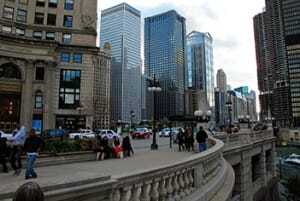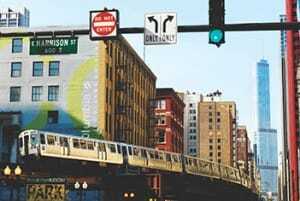At a board meeting in July of the newly formed Chicago Infrastructure Trust, the quasi-governmental organization’s chief executive Stephen Beitler floated an idea that would appeal to anyone who has endured one of the city’s harsh winters: why not build a network of pipes beneath city streets, and fill it with geothermal-heated steam that would melt the snow and clear the way for traffic?
Other places heat their pavement—Klamath Falls, Oregon, and Ninohe, a small city in northern Japan, have been doing it for decades—but this strategy has yet to be attempted in a city of Chicago’s size. What would be even more innovative about the project—if it is ever actually built—is that Chicago taxpayers might not have to pay a cent toward its yet-to-be-calculated cost. Instead, the infrastructure trust would raise funds from private institutional investors, who would make their return from getting a share of the money that the city would save by not having to deploy its fleet of snow plow trucks every time the weather got bad.
“The idea is that you should at least look at ideas and see if they’re realistic,” Beitler explained at the time in an article on Chicagobusiness.com.
That Chicago is even considering such innovations—at a time when its finances are straining under the weight of pension obligations and a sagging bond rating—is an indication of the transformative potential of the Chicago Infrastructure Trust, an organization created by the city council at the behest of Mayor Rahm Emanuel in April 2012. The trust’s mission is to devise and orchestrate projects to help give the city’s aging transportation system, public buildings, and energy production a badly needed upgrade, and to repurpose vacant or underused properties to promote economic development and improve the city’s tax base. To pay for all that, the trust aims to raise $1.7 billion in private-sector capital by finding ways to structure deals so that investors can realize a return, even as the public benefits from the investment.
“Basically, if I were sitting in front of you, I would hold my hands two feet apart, and say that the city of Chicago has that much money,” Beitler says. “Then I’d hold my hands six feet apart and say: That is the number of projects that the city needs. The challenge is to find the money to pay for the remaining four feet.”
That might seem like a daunting assignment, even for someone such as Beitler, a retired lieutenant colonel in the U.S. Army’s elite Green Berets who went on to work in private equity and to found his own venture capital firm, Dunrath Capital, which today manages a $100 million portfolio of investments in defense and security manufacturers. But if the trust—the first such entity of its kind in the United States, according to infrastructure and finance experts—turns out to be successful, it is likely to inspire similar efforts in cities across the nation.
“If Chicago can point the way for other cities to attract new forms of financing, it will have done a great service,” Citigroup vice chairman Peter Orszag, the former director of the Office of Management and Budget in the Obama administration, wrote in an opinion piece for Bloomberg.com earlier this year.
Mayor Emanuel devised the trust to deal with what is an escalating dilemma for cities across the nation. In a 2013 report, the American Society of Civil Engineers (ASCE) gave the nation as a whole a D+ grade for the condition of its roads, bridges, railways, drinking and wastewater systems, and other parts of its infrastructure, and noted that it would require a breathtaking $270 billion in investment just to modernize and maintain crumbling schools in U.S. communities. The overall price tag for upgrading the nation’s infrastructure to acceptable levels could reach $3.6 trillion over the course of the next decade, according to ASCE.
Chicago, in many ways, is a microcosm of the national infrastructure problem. To a downtown visitor, it is a city with a glittering skyline full of architectural landmarks, a bustling mixed-use downtown, and a vibrant cultural life—a place that still seems to deserve to be called “the City That Works,” a moniker bestowed by legendary mayor Richard J. Daley back in the 1960s. But beneath that robust ambiance, much of the critical infrastructure that keeps the city working is in need of repair or replacement, from the century-old stations on its trademark elevated train line to some 900 miles (1,400 km) of equally ancient water pipes. The city’s grand but antiquated government buildings and schools waste vast amounts of energy.
Yet another problem is the large number of vacant houses and rusting former industrial sites—an inventory that has swelled to 15,000 city-controlled parcels, with more being added each month. “A significant portion of the land in the city is not on the tax rolls,” Beitler says. “I view that as problematic. The trust can make a difference, in assisting the city to get those properties properly utilized to [their] highest and best use. If they’re generating tax revenue, they can support things such as education.”
But that city-controlled land, which Beitler estimates represents 15 to 20 percent of the real estate within Chicago’s borders, also presents an opportunity for Chicago to morph into a metropolis capable of meeting the challenges of the 21st century. As he sketched out during the trust’s July board meeting, vacant industrial spaces could be repurposed for solar and wind electricity generation, while other properties could be redeveloped as data facilities or low-income housing, or as urban farms that would help the city become more self-sufficient in terms of its food supply. “The mayor has the goal of making Chicago one of the greenest—if not the greenest—cities in the world,” Beitler says. “The trust can help accomplish that goal.”
“Creating an organization like the Chicago Infrastructure Trust is a way to build up institutional expertise in the public sector, which can persist over the years and through different deals. It doesn’t matter whether they’re doing a water deal or airports or parks—they can apply one consistent methodology.” - Roy Kienitz
A Better Deal than Bonds?
Traditionally, local governments have raised capital for infrastructure projects through the bond market, where the interest rates they have paid generally have been far lower than the rate of return that private equity players expect from companies in which they invest. But for Chicago, the cost of borrowing is now likely to be sharply higher thanks to a recent three-notch downgrade of its existing $11.5 billion in debt by Moody’s Investor Service, which gave the city an A3 with negative outlook, thanks in part to its massive unfunded pension liabilities.
“The spread, or delta, between public and private financing may not be as dramatic at this point,” Beitler explains. “That goes a long way toward letting [cities] use alternative financing. Maybe in some cases, we’ll be able to offer financing that’s even cheaper.”
The idea of getting private investors to participate directly in public projects is not a new one. Public/private partnerships (PPPs), in which private companies play some role in the financing, design, construction, or some aspect of operation of a project, have been used to build commuter rail in Colorado, a tunnel project in Florida, road improvements in Texas and Virginia, and for other projects.
Infrastructure experts say that PPPs—also known as P3s—are often able to complete public infrastructure projects more quickly and at lower cost than conventionally financed and managed ones, because private sector participants tend to get things done more efficiently. According to a 2011 article by William Renhardt in the journal Public Works Financing, research has shown that PPPs resulted in capital cost savings of 15 percent, and were delivered 14 percent faster than traditionally structured projects.
“Part of our job is to get people to look at project costs differently than just focusing on the cost of the bond [compared to other financing],” Beitler says. “If we can accomplish that, they’ll get a truer picture of the total cost over the life of the project.”
Since its 2012 inception, the Chicago Infrastructure Trust has moved at a deliberate speed that has frustrated some local critics. “It’s been over a year, and not a single project has moved forward,” complains Amisha Patel, executive director of the Grassroots Collective, a coalition of Chicago community groups. “That’s after the mayor was in such a hurry to push this through council.” Patel and others also have questioned whether the trust’s deals will benefit the public as well as investors. Such local skepticism runs high, in part because Chicagoans are still smarting from the sharply higher parking fees imposed by a private consortium that took over the city’s meters in 2010 under then-mayor Richard M. Daley, in exchange for $1.15 billion that now seems to many to be too low of a price.
In his lobbying effort to establish the infrastructure trust, Emanuel promised that it would not relinquish any public assets in such a fashion. As its first deal, the trust has been working on financing $200 million in energy-efficiency upgrades of government buildings and schools. While that deal is still being crafted, an analysis of early proposals by the Bond Buyer, a financial publication, indicates that investors may be offered a share of the savings from reduced labor, maintenance, and energy bills. The city would retain ownership of the refurbished facilities. Another novel wrinkle: The financing would blend the credit of three separate public agencies—the city’s departments of Water Management and Fleet and Facilities Management, and the Chicago Public Schools.
Though the trust had not yet clinched a deal as of late September, it had attracted a dozen interested potential investors. They ranged from familiar names such as Citigroup, J.P. Morgan, and PNC to lesser-known entities such as Hapoalim Securities, a subsidiary of Israel’s largest bank, and Green Campus Partners, a New Jersey–based firm that invests in renewable energy projects.
Some critics have attacked the deal, noting that it has proceeded so slowly that when it finally closes, the trust is likely to end up reimbursing the city schools for energy-efficiency upgrades that school officials already have implemented. Nevertheless, Don Cohen, executive director of In the Public Interest, a government accountability lobbying organization based in Washington, D.C., praises the energy-efficiency effort as the sort of project that an infrastructure trust should be doing. “It’s important to have deals where the interest of the public is aligned with the interests of the investors,” he explains. “This is not some deal to build a toll road, where it’s in the interests of the investors to have more people driving, which results in more traffic congestion and pollution for the public. In Chicago, the first thing they’re doing is ‘greening’ the buildings. The more energy costs they save, the better that both the public and the investors will do.”
A working document issued by the trust in July sketches out the broader outlines of how the trust may work in the future. The organization will orchestrate full-scale—not demonstration—projects. It will concentrate on three main areas: improving the efficiency and environmental friendliness of energy production and consumption; repurposing underused land, buildings, rights-of-way, and other city assets to reduce public costs and increase revenue; and improving local transportation to provide better service and decrease congestion at lower cost. Some projects may overhaul existing infrastructure, while others will build new infrastructure where none exists. The deals will have a 20-to-40-year duration, and typically the city will own the asset that is created, with the private stakeholders sharing in a portion of the revenue stream, or else receiving a fee to operate the asset.
To foster transparency, Emanuel put in a rule that the city council must vote on every trust-financed project that involves city money, assets, or property—but not all projects financed by the trust for city sister agencies like Chicago Public Schools, the Chicago Park District, or the Chicago Transit Authority. He also issued an executive order requiring the trust board to pick outside analysts to evaluate each deal and conduct annual financial reviews.
“This is not some deal to build a toll road, where it’s in the interests of the investors to have more people driving, which results in more traffic congestion and pollution for the public. In Chicago, the first thing they’re doing is ‘greening’ the buildings. The more energy costs they save, the better that both the public and the investors will do.” - Don Cohen
The economic impacts of deals that the trust may do are harder to calculate, but they may be substantial. Mary Sue Barrett, president of the Chicago region’s Metropolitan Planning Council and a member of the infrastructure trust’s advisory board, says the trust’s projects have the potential to create new markets for locally manufactured products from the Chicago region and elsewhere in Illinois. “We’ve got manufacturers of parts for wind turbines, for example,” she notes. “Chicago hasn’t been the biggest market for these items, but we could change that.”
Nonetheless, the infrastructure trust concept—if it succeeds in Chicago—seems likely to be emulated elsewhere. In one obvious sign, the U.S. Conference of Mayors appointed Emanuel to head its task force on finding new ways to obtain infrastructure financing. Philadelphia Mayor Michael Nutter, who heads the mayors’ conference, praised the Chicago effort for “looking outside the box to leverage private financing for these critical projects.”
Roy Kienitz, a former U.S. Department of Transportation official who now works as an infrastructure financing consultant, says that the concept of a single quasi-governmental group making strings of deals on behalf of a local city and all of its various agencies has potentially huge advantages. “One problem in a traditional bureaucracy is that the schools, the streets, water, the airports, and so on all tend to be run by different organizations,” he explains. “That means that when one of them does a public/private partnership, there tends to be a big asymmetry between the public and the private partner, in terms of relative experience at doing these agreements. Creating an organization like the Chicago Infrastructure Trust is a way to build up institutional expertise in the public sector, which can persist over the years and through different deals. It doesn’t matter whether they’re doing a water deal or airports or parks—they can apply one consistent methodology.”
Conversely, Kienitz also likes what private sector participants can bring to a project besides just money. “One of the things about government is that it’s good at saying no because it doesn’t have the money, but not so good at saying no because a project isn’t a viable idea, if there’s political support for it. The private sector is good at saying that something doesn’t make sense from a cost-benefit standpoint, that this isn’t an investment you should make. They can push back at each other, which results in better balance.”
For the time being, though, Beitler is less focused on creating a new template for municipal financing, and more focused on getting the first-ever infrastructure trust to work. “Financing is a project-specific activity,” he says. “[The trust] isn’t so much an attempt to find innovative financing mechanisms, as it is to find the appropriate one for whatever project we’re working on.” But in the long run, he says, “hopefully we’ll find new sources of capital, instead of having to resort to the tried-and-true methods most municipalities use today.”
Patrick J. Kiger is a Washington, D.C.–area journalist, blogger, and author.








